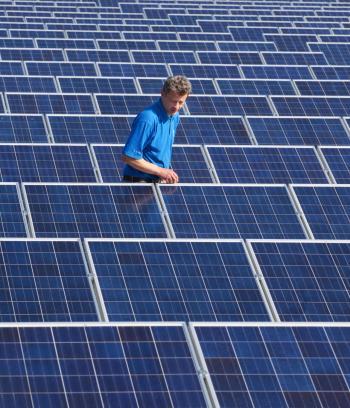SAN FRANCISCO—Electric utilities in the nation are warming to the growing significance of solar power in a shift that promises to alleviate grid congestion during peak hours by harnessing electricity from sunshine.
California’s energy provider, Pacific Gas and Electric (PG&E), signed contracts last week with two companies to buy 800 megawatts of solar-generated electricity. The amount of electricity generated from sunlight will be enough to power 239,000 homes or 800 Wal-Marts annually.
Within three years, PG&E will buy its solar electricity from subsidiaries of OptiSolar and SunPower companies, which plan to build the world’s two largest solar plants in California. And as part of the deal the solar farms are expected to begin power supply by 2011 and be fully operational by 2013.
“These landmark agreements signal the arrival of utility-scale photovoltaic solar power that may be cost-competitive with solar thermal and wind energy,” said Jack Keenan, chief operating officer and senior vice president for PG&E.
The two vast solar farms, covering more than 12 square miles with photovoltaic modules, would provide 1.65 billion kilowatt-hours of electricity per year, peaking daily in the afternoon, just when electricity demand is at its highest.
The solar power plants are expected to dwarf existing solar facilities such as the current largest U.S. solar plant, Nellis Air Force Base in Nevada, and rival fossil-fuel driven plants.
At present the total amount of photovoltaic solar panels connected to the grid in the entire U.S. is just 473 megawatts. The new project is expected to nearly double the entire solar panel capacity in the country, which is still less than one percent of the nation’s generated power. But the solar energy trend is growing, driven by falling solar prices and states’ clean-energy mandates.
Although the two massive solar plants will help the California mandate of sourcing 20 percent of its electricity from renewable resources, they may be hindered financially if the federal government does not reward the development of such projects through a tax credit program.
One of the solar farms, located in San Luis Obispo, California, would utilize relatively low-cost, thin-film photovoltaic panels manufactured by OptiSolar in Hayward and would deliver an average of 1.1 million megawatt-hours annually of renewable electricity.
“Our solar farms are quiet and emission-free, with solar panels mounted near ground level to minimize visual impact, said Randy Goldstein, chief executive of OptiSolar.
Crossover Point
The second solar plant, also located in San Luis Obispo, will deliver an average of 550,000 megawatt-hours of solar electricity and would employ crystalline photovoltaic solar cells designed by SunPower. The solar cells generate up to 50 percent more power than conventional crystalline cells, which will also tilt toward the sun throughout the day, increasing energy capture.
As solar technology prices decline and the fuel costs for coal, natural gas and nuclear plants rise, the U.S. may reach a crossover point to achieve 10 percent solar by 2015, projects a study published by clean-tech research and publishing firm Clean Edge based in California.
Solar power delivers energy at zero fuel costs, minimal maintenance and zero carbon emissions, but the investment needed for the United States to arrive at 10 percent solar is not small, reaching $26 billion to $33 billion per year. The study remains optimistic, stating that utilities spent an estimated $70 billion on new power plants and distribution systems in 2007 alone.
Since last year, a number of utilities and solar companies have announced aggressive programs to deploy large-scale solar power projects. Florida Power & Light and Sempra Generation, a power wholesaler, each plan to build solar farms of up to 25 megawatts in Florida and Nevada.
Utilities throughout the U.S. have been installing photovoltaic modules on neighborhood rooftops that feed into their grids. Duke Energy in North Carolina stated a goal of investing $100 million in rooftop solar modules. Southern California Edison began installing panels on 100 warehouses in the Los Angeles area, and plans to invest in 250 megawatts of rooftop photovoltaic panels.
PG&E is still the leader in providing solar energy, according to Julia Hamm from the Solar Electric Power Association. “They continually raise the bar for other utilities, and send a clear message that solar electricity is an option to be taken seriously by all those in the energy business,” Hamm said in a statement.
The barren deserts of Southern California, known for relentless sunshine and miles of empty space have also been eyed by utilities to invest in thousands of megawatts of concentrated solar power.





Friends Read Free